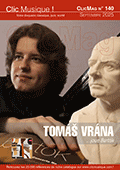 « Il Maestro dei Maestri » ! Bruno Bettinelli mène au long du siècle dernier une carrière discrète de pédagogue et de professeur de composition à Milan, sa ville natale. Abbado, Muti, Chailly, Pollini comptent parmi ses nombreux élèves ! Il compose également et construit, à partir de 1938, avec sa « Symphonie de Chambre », patiemment, une œuvre très diverse, en particulier chorale et orchestrale, à l’écoute et en dialogue avec ses contemporains. Chiara Cipelli, avec science et délicatesse, nous offre un florilège des œuvres pour piano seul de Bettinelli, composées entre 1941 et 1974, sorte de gradus du piano moderne, visant, selon le compositeur, l’émotion de l’auditeur plutôt que la spéculation esthétique ou l’autotélisme pianistique. Si l’intention didactique à l’usage des jeunes pianistes est souvent présente, des « Petites Pièces pour piano forte » (1941), miniatures de quelques secondes à deux minutes, à « Sintesi » (1974), revue de formes et de styles musicaux, l’évolution du langage pianistique y est néanmoins manifeste dont témoignent les langages musicaux de la « Suite agreste » aux citations debussystes (1946) et de la « Fantaisie pour piano forte » (1955) très articulée, à la volubilité percussive, « ritmico » en hommage à Stravinski, et du « Prélude » (1956) au syncrétisme moderniste. Musique séduisante et mélodique, au lyrisme affirmé, d’un musicien engagé dans son temps, dans la filiation italienne de Casella et de Malipiero, proche en esprit de Luigi Dallapiccola à qui il rend également hommage. A connaître. (Emilio Brentani)  The first thorough survey on record of piano music by a major figure in the musical landscape of 20th-century Italy. As a teacher of theory and composition at the Accademia di Santa Cecilia in Rome, Bruno Bettinelli (1913-2004) had a decisive influence on the careers of Claudio Abbado, Riccardo Chailly, Riccardo Muti and Maurizio Pollini. At least outside his native Italy, his work as a teacher has overshadowed his own music, which is now being recognised as the output of a distinctive voice in the generation between Luigi Dallapiccola and modernist pioneers such as Luigi Nono. Like his chamber music, however, Bettinelli’s piano music also reveals a debt to the instrumental composers at the turn of the last century who worked against the grain in this land of lyric and song: men such as Casella, Malipiero and Ghedini, all of them represented on Brilliant Classics with important revivals of chamber and piano music. Bettinelli deserves his place alongside them, as a first listen to the bold Fantasia will make clear. Composed in 1955, the five sections of the Fantasia make free use of tonality in the context of post- Romantic writing for the piano that presents a challenge to the most accomplished technique; one which Chiara Cipelli overcomes with flying colours. The most ambitious work on the album, the Fantasia is preceded by the more picaresque charms of a three-movement Suite agreste and followed by two contrasting collections of miniatures, the 18 Easy Pieces from 1941 – owing something to neoclassical Hindemith – and the 10 exquisite fragments which make up Sintesi. Written in 1970, Sintesi distils Bettinelli’s own adoption of atonal technique to its most poetic essence. Chiara Cipelli is herself active as a teacher, as a professor of piano in Cremona and Reggio Emilia, but also maintains a busy performing career, with concerts across Europe and the US and a repertoire that places emphasis on the music of our time.
 |
